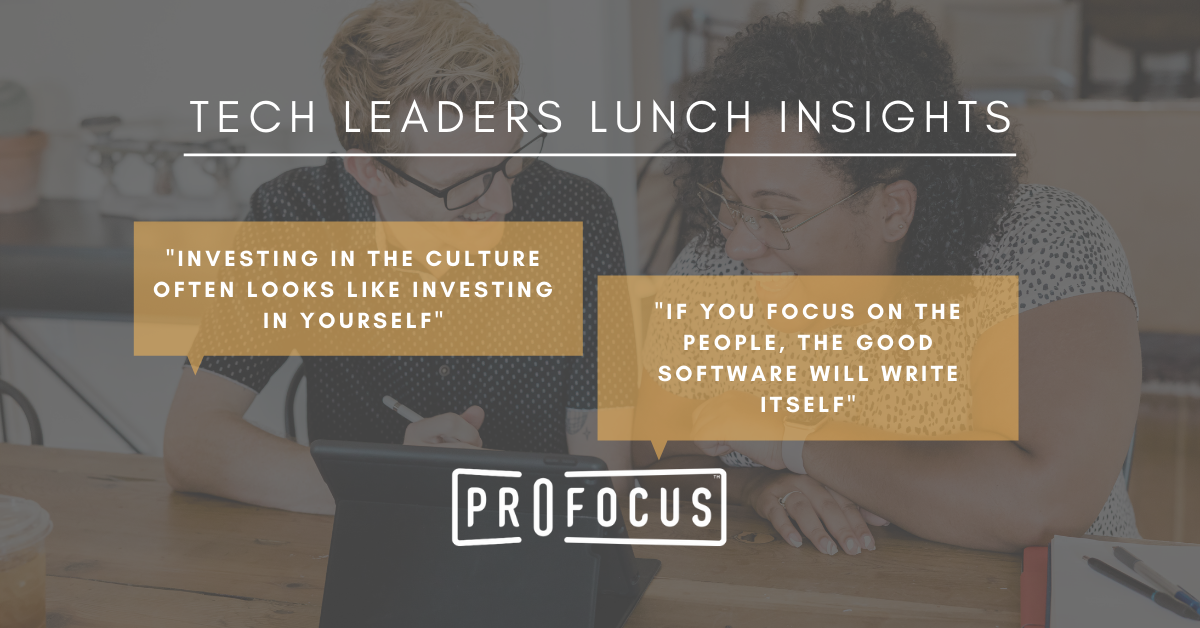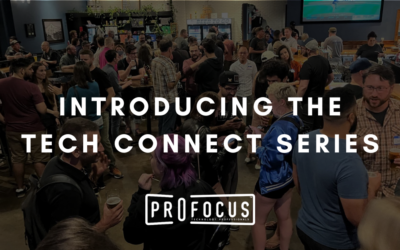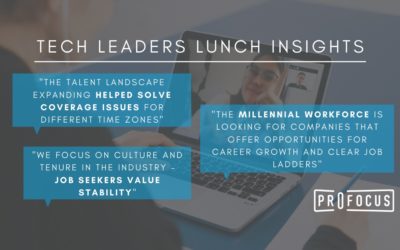Tech Leaders Lunch:
Investing in Culture & Team Building
Known for its natural beauty and vibrant neighborhoods, the City of Roses lives up to its reputation as a great place to live and work. Once again, Portland firms get high marks for company culture from tech professionals in our 2022 Tech Trends Report. More than three-quarters (78%) say their firm builds and maintains a positive culture, slightly up from 75% last year.
How and why do tech leaders invest in culture and team building?
In December 2021, ProFocus hosted a discussion with eight IT leaders to address this question and share their strategies and leadership styles. The insights below are based on the notes and resources shared in the discussion.
The CEO & HR Don’t Create Company Culture
The leaders in our discussion agreed, everyone in the organization must understand and connect to the company’s culture because it helps people throughout the company to make decisions.
“A new culture-building approach is already in place at some organizations, one in which everyone in the organization is responsible,” says Denise Lee Yohn of the Harvard Business Review. “Importantly, this model doesn’t relegate culture-building to an amorphous concept that everyone influences but no one leads or is accountable for. Shared responsibility for culture throughout an organization involves different people and functions within the organization playing different roles in developing and maintaining the culture.”
Assess Your Culture
Here are some questions IT leaders are asking when assessing their company’s culture:
- How do you bring people in that shape and change company culture?
- How does a company remain flexible and keep culture malleable?
- How to maintain and build culture remotely?
- How to create social safety?
Example Strategies
One leader spoke about an informal program he started to connect “the ‘hard-working’ and ‘working out’ colleagues in his organization. Now getting up, staying active AND taking healthy breaks are a normal part of this team’s culture. He said it “brings out the best in people.”
Another manager spoke to a similar theme at their organization – investing in the culture often looks like investing in yourself. They said, “If you focus on the people, the good software will write itself.”
When this manager’s company hired someone from Wall Street that wasn’t familiar with the organization’s values they partnered the new hire with a person that knew the culture really well. The intentional match-up helped the manager keep consistency and add a new perspective.
This tech leader shared how his organization requires each person to read certain books. Which gives them “more perspective on different roles, and helped me see the pain points of other folks in the organization.” Please see the resources section below for more.
Remote Culture
One example of how to invest in your culture is focused on sharing food and sharing time. This leader managed a team in Argentina and they’d eat breakfast together as a team and every team made a funny video to introduce to other teams. Having cross-team activity really helps the team to understand the different backgrounds of each team member and allows them to connect effectively.
Another tech leader shared how they try to find ways to keep their team interacting through games, pairings, and events. They mentioned that something like this has to be an ongoing effort.
But Remote Isn’t for Everyone
During the discussion, a manager mentioned they had to let someone go that wasn’t a good fit for a remote environment. They said unfortunately, it becomes apparent very quickly because other teammates will recognize if the other is not producing. This manager provided the team member with a list of companies that require hybrid or on-site, knowing that it was a better environment for the team member and not something that their company could provide.
Own the Outcome
“I approach culture with the long game in mind – we create a social safety and that’s not automatic, we have to work for it,” says a local tech leader. They dive into interactions with the intention of finding:
- What lights them up?
- What’s bothering them?
By balancing personal and professional, this manager really focuses on the “human-first perspective.” They also hold their leadership team accountable when there is attrition.
Diversity, Equity, & Inclusion in the Workplace
Almost a third of U.S. job seekers say they wouldn’t apply to a company with no workforce diversity. Companies must actively support and promote a range of DEI initiatives. The most popular programs indicated in our recent survey address both recruiting and retention initiatives. You can find more about this in our recently released 2022 Tech Trends Report.
Resources & Suggestions for IT Leaders
- In this instant New York Times bestseller, pioneering psychologist Angela Duckworth shows anyone striving to succeed—be it parents, students, educators, athletes, or business people—that the secret to outstanding achievement is not talent but a special blend of passion and persistence she calls “grit.” Why do some people succeed and others fail? Sharing new insights from her landmark research, Angela explains why talent is hardly a guarantor of success. Check out the book here.
- America’s most sought-after executive coach shows how to climb the last few rungs of the ladder. The corporate world is filled with executives who have worked hard for years to reach upper management. They’re intelligent, skilled, and even charismatic. But only a handful of them will ever reach the pinnacle — and as executive coach Marshall Goldsmith shows in this book, subtle nuances make all the difference. Small “transactional flaws” performed by one person against another (as simple as not saying thank you enough), which lead to negative perceptions that can hold any executive back. Using Goldsmith’s straightforward, jargon-free advice, it’s amazingly easy behavior to change. Executives who hire Goldsmith for one-on-one coaching pay $250,000 for the privilege. With this book, his help is available for 1/10,000th of the price.
- Everything we’ve previously been taught about negotiation is wrong: you are not rational; there is no such thing as ‘fair’; compromise is the worst thing you can do; the real art of negotiation lies in mastering the intricacies of No, not Yes. These surprising tactics—which radically diverge from conventional negotiating strategy—weren’t cooked up in a classroom. These are the field-tested tools FBI agents used to talk criminals and hostage-takers around the world in unimaginable situations. In NEVER SPLIT THE DIFFERENCE: Negotiating As If Your Life Depended On It, former FBI lead international kidnapping negotiator Chris Voss and co-author Tahl Raz break down these strategies so that anyone can use them in the workplace, in business, or at home.
- Many corporations have slick, flashy mission statements. That ultimately does little to motivate employees and less to impress customers, investors, and partners. But there is a way to share your excitement for the future of your company in a clear, compelling, and powerful way and entrepreneur and business growth expert Cameron Herold can show you how. Vivid Vision is a revolutionary tool that will help owners, CEOs, and senior managers create inspirational, detailed, and actionable three-year mission statements for their companies. In this easy-to-follow guide, Herold walks organization leaders through the simple steps to creating their own Vivid Vision, from brainstorming to sharing the ideas to using the document to drive progress in the years to come.
If you are a leader in the IT industry and would like to be involved in future roundtable discussions like the one above, please send an email to [email protected] with a request to be invited to upcoming Leaders Lunches.




